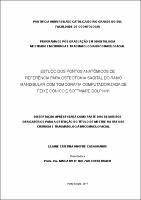| Share record |


|
Please use this identifier to cite or link to this item:
https://tede2.pucrs.br/tede2/handle/tede/7553| Document type: | Dissertação |
| Title: | Estudo dos pontos anatômicos de referência para osteotomia sagital do ramo mandibular com tomografia computadorizada de feixe cônico e software Dolphin* |
| Author: | Casagrande, Liliane Cristina Onofre  |
| Advisor: | Rockenbach, Maria Ivete Bolzan |
| Abstract (native): | A osteotomia sagital do ramo mandibular é amplamente utilizada para a correção cirúrgica das deformidades dentais e esqueléticas. O desenvolvimento histórico da técnica iniciou com Hugo Obwegeser, em 1957. As incansáveis propostas de alteração da técnica de osteotomia sagital do ramo mandibular se originaram com a intenção de administrar e minimizar as várias complicações trans e pós-cirúrgicas encontradas durante a realização desse procedimento. Por se tratar de uma técnica usualmente utilizada em pacientes jovens e saudáveis, as taxas de complicações devem ser controladas e os possíveis fatores de confusão devem ser detectados e corrigidos. O presente estudo teve como objetivo identificar pontos anatômicos mandibulares, utilizando tomografias computadorizadas de feixe cônico (TCFC), e analisar sua relação com áreas e estruturas importantes para o planejamento cirúrgico, em exames de pacientes portadores de oclusão dentária classe I, II ou III utilizando o software Dolphin®. Foram avaliadas as imagens tomográficas de 27 pacientes distribuídos entre os três grupos. Foram encontradas diferenças estatisticamente significantes entre as três deformidades avaliadas entre os sexo feminino e masculino. Entretanto, o canal mandibular esteve mais afastado da placa cortical vestibular nos pontos entre a raiz distal do primeiro molar e a raiz distal do segundo molar, e mais próximo da placa lingual na região entre 1M e 2M, nas três classes. |
| Abstract (english): | The sagittal split ramus osteotomy is widely used for the surgical correction of den-tofacial deformities. The techniques historical development began with Hugo Obwer-geser in 1957. The relentless proposals for alterations of the sagittal split ramus oste-otomy technique originated with the intention of administering and minimizing the var-ious trans and pos-operative complications that happened during the performance of this procedure. As this is a technique usually employed with young healthy patients, the rates of complications must be controlled and the possible factors of confusion must be detected and corrected. The present study had the purpose of identifying mandibular anatomical points, using cone beam computed tomography, and ana-lise their relation with areas and structures that are important for surgical planing, in the exams of patients with retrognathism, prognathism and with a balanced maxillo-mandibular pattern using Dolphin® software. 27 tomographic patient images were dis-tributed into the three groups and were evaluated. Significant statisti-cal diferences were found between the three evaluated deformities and between men and women. However, the mandibular canal had a greater distance to the vestibular cortical plate in the points between the distal root of the first molar and de distal root of the second molar, and was closer to the lingual plate in the region between 1M and 2M, in all three classes. |
| Keywords: | Osteotomia Sagital do Ramo Mandibular Tomografia Computadorizada de Feixe Cônico Deformidade Dentofacial Prognatismo Retrognatismo |
| CNPQ Knowledge Areas: | CIENCIAS DA SAUDE::ODONTOLOGIA |
| Language: | por |
| Country: | Brasil |
| Publisher: | Pontifícia Universidade Católica do Rio Grande do Sul |
| Institution Acronym: | PUCRS |
| Department: | Faculdade de Odontologia |
| Program: | Programa de Pós-Graduação em Odontologia |
| Access type: | Acesso Aberto |
| Fulltext access restriction: | Trabalho não apresenta restrição para publicação |
| URI: | http://tede2.pucrs.br/tede2/handle/tede/7553 |
| Issue Date: | 30-Mar-2017 |
| Appears in Collections: | Programa de Pós-Graduação em Odontologia |
Files in This Item:
| File | Description | Size | Format | |
|---|---|---|---|---|
| DIS_LILIANE_CRISTINA_ONOFRE_CASAGRANDE_PARCIAL.pdf | Texto Parcial | 251.53 kB | Adobe PDF |  Download/Open Preview |
Items in DSpace are protected by copyright, with all rights reserved, unless otherwise indicated.




